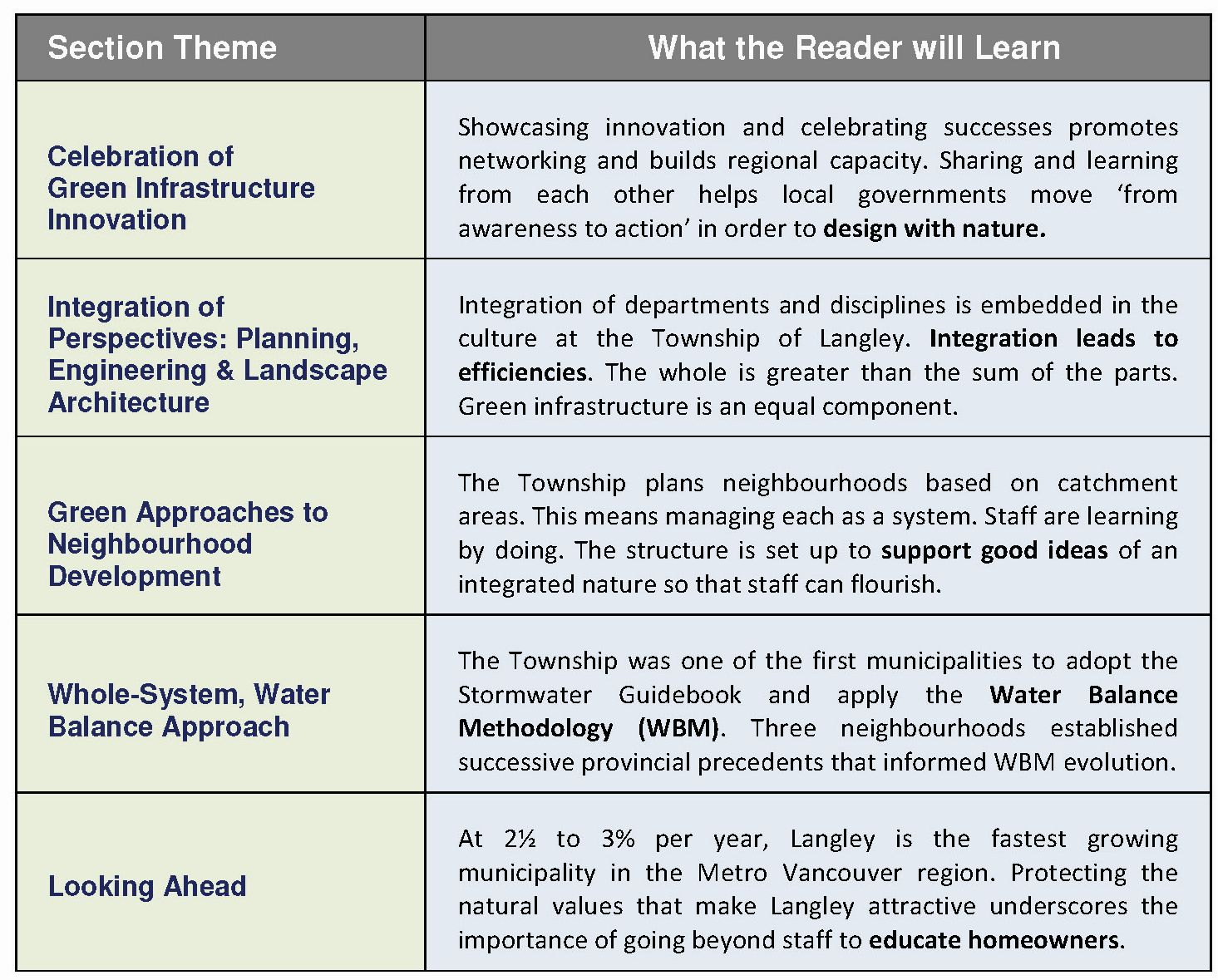GREEN INFRASTRUCTURE INNOVATION IN THE TOWNSHIP OF LANGLEY: A decade ago, three neighbourhood developments in Langley established successive provincial precedents that informed the evolution of the Water Balance Methodology
Note to Reader:
 The Langley Township story is the fifth in a series of Watershed Blueprint Case Profiles published by the Partnership for Water Sustainability.
The Langley Township story is the fifth in a series of Watershed Blueprint Case Profiles published by the Partnership for Water Sustainability.
The series showcases and celebrates successes and long-term ‘good work’ in the local government setting.
The purpose of the series is to inform and facilitate inter-regional collaboration in the Georgia Basin.
By telling the stories of those who are spearheading changes in practice, this helps other local governments eliminate the “disconnect between information and implementation” that may otherwise hold them back.
Langley: A Leader by Example
“In 2002, Stormwater Planning: A Guidebook for British Columbia established a new direction for drainage engineering. This is known as the Whole-System, Water Balance Approach. Over the past 15 years, the Township has established important precedents that demonstrate how to implement this approach,” wrote Kim Stephens, Partnership Executive Director and author of Green Infrastructure  Innovation in Langley Township.
Innovation in Langley Township.
“The Township was an early adopter of the Guidebook philosophy, and was one of the first municipalities to apply the Water Balance Methodology. The methodology provides the technical foundation for the Whole-System, Water Balance Approach. In 2005, the Township became a partner in the Water Balance Model initiative.
“Three neighbourhoods in the Willoughby Development Area – Routley, Yorkson and Northeast Gordon Estates – established successive provincial precedents that informed the evolution of the Water Balance Methodology.”
Green Infrastructure Precedents
Each neighbourhood features a different innovation in order to ‘design with nature’:
- Routley: A multi-purpose greenway and shallow infiltration systems on individual properties.
- Yorkson: A third-pipe system for roof drainage connects to a sand filtration treatment system, with provision for future deep-well injection for aquifer recharge.
- North East Gordon Estates: Truly ‘green’ streets!
These three neighbourhoods allowed the Township to learn by doing and adapt. Staff continue to build on this early experience.
DFO Approvals:
“Langley is unique in that DFO (Department of Fisheries & Oceans) approved the water balance strategy at a neighbourhood scale for each of Routley, Yorkson and Northeast Gordon,” stated Jim Dumont, Engineering Applications Authority,  Partnership for Water Sustainability in British Columbia. He is the engineer of record for the Routley, Yorkson and Northeast Gordon water balance implementation plans
Partnership for Water Sustainability in British Columbia. He is the engineer of record for the Routley, Yorkson and Northeast Gordon water balance implementation plans
“This meant that design standards were applied uniformly across each neighbourhood. This was a time-saver for everyone. The approach resulted in consistency of implementation.
“The online Water Balance Express, a tool for use by homeowners, is a natural progression of this experience. The tool would enable easier implementation of water balance requirements.”
Water Balance Methodology
As understanding has grown, the Water Balance Methodology has evolved; and this is reflected in the successive rainwater management plans for the Routley, Yorkson and Northeast Gordon neighbourhoods.
In 2003, Routley showed that something could be done to protect the fisheries resource. The Routley experience demonstrated how to reduce rainwater runoff volume. It pre-dated East Clayton in Surrey. Routley was the first application of the Water Balance Methodology in its original form as laid out in the Guidebook.
Yorkson was the first application of the Water Balance Methodology as it evolved after 2003 to incorporate flow-duration. This is important because the critical parameter for stream stability is the number of hours per year of erosion-causing streamflow rates. The flow-duration relationship is the cornerstone of the methodology.
To Learn More:
To read the complete story, download a copy of the Watershed Case Profile. Click on Green Infrastructure Innovation in Langley Township, released in October 2017.
The Table of Contents below is a synopsis. It distills the essence of each section into a succinct statement. These create a storyline. Readers are asked to pause and reflect on them before reading the story itself.




